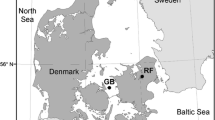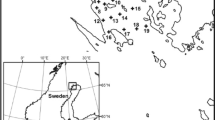Abstract
The response of planktonic bacteria and phytoplankton to various additions of dissolved organic carbon (DOC) as glucose, with and without inorganic nutrients (nitrogen and phosphorus), was tested in the upper to mid Hunter Estuary, Australia. In situ microcosms (1.25 L) were performed at two sites with varying salinities over three seasons. Analysis of variance showed a significant difference among control and treatments for all seasons for the bacterial, dissolved oxygen and chlorophyll a responses (P < 0.05). A significant interaction between treatment and site was found in autumn for dissolved oxygen, autumn and spring for bacterial and spring for chlorophyll a responses. At both sites for each season, and on nearly all occasions, bacterial surface area was enhanced by DOC addition as indicated by both increased bacterial abundance and dissolved oxygen utilisation. DOC in combination with inorganic nutrients sometimes further enhanced the bacterial response compared to DOC alone. Inorganic nutrients alone did not enhance growth of the heterotrophic bacterioplankton. Addition of DOC alone led to decreased chlorophyll a relative to the control, probably due to competition for limited inorganic nutrients with the bacterioplankton DOC non-limiting conditions. Results suggest that the heterotrophic community was limited by DOC at both sites and across seasons. An experiment with a larger volume (70 L), performed over a longer time, compared a control with DOC addition. Increased bacterial biomass as a result of DOC addition occurred at day 2. Chlorophyll a did not significantly differ between treatments. An increase in zooplankton density was recorded in the DOC treatment relative to the control at day 10. This study supports the contention that increased DOC delivery with river inflows through environmental flow allocations will stimulate heterotrophic bacterioplankton production in the upper Hunter Estuary.






Similar content being viewed by others
References
Aitkenhead-Peterson, A., W.H. McDowell, and J.C. Neff. 2003. Sources, production, and regulation of allochthonous dissolved organic matter inputs to surface waters. In Aquatic ecosystems: Interactivity of dissolved organic matter, ed. S.E.G. Findlay and R.L. Sinsabaugh. San Diego: Academic.
APHA (American Public Health Association). 1998. Standard Methods for the Examination of Water and Wastewater, 20th ed. Washington DC: American Public Health Association.
Bayly, I.A.E. 1963. A revision of the coastal water genus Gladioferens (Copepoda: Calanoida). Australian Journal of Marine and Freshwater Research 14: 194–217.
Benner, R., S. Opsahl, G. Chin-Leo, J.E. Richey, and B.R. Forsberg. 1995. Bacterial carbon metabolism in the Amazon River system. Limnology and Oceanography 40: 1262–1270.
Benner, R. 2003. Molecular indicators of the Bioavailability of dissolved organic matter. In Aquatic ecosystems: Interactivity of dissolved organic matter, ed. S.E.G. Findlay and R.L. Sinsabaugh. San Diego: Academic.
Boak, A.C. and R. Goulder. 1983. Bacterioplankton in the diet of the calanoid copepod Eurytemora sp. in the Humber Estuary. Marine Biology 73: 139–149.
Bouvy, M., M. Pagano, M. M’Boup, P. Got, and M. Troussellier. 2006. Functional structure of microbial food web in the Senegal River Estuary (West Africa): Impact of metazooplankton. Journal of Plankton Research 28: 195–207.
Caffrey, J.M. 2004. Production, respiration and net ecosystem metabolism in U.S. estuaries. Environmental Monitoring and Assessment 81: 207–219.
Capriulo, G.M., G. Smith, R. Troy, G.H. Wikfors, J. Pellet, and C. Yarish. 2002. The planktonic food web structure of a temperate zone estuary, and its alteration due to eutrophication. Hydrobiologia 475(476): 263–333.
Caron, D.A. 1994. Inorganic nutrients, bacteria and the microbial loop. Microbial Ecology 28: 295–298.
Caron, D.A., E.L. Lim, R.W. Sanders, M.R. Dennett, and U.G. Berninger. 2000. Responses of bacterioplankton and phytoplankton to organic carbon and inorganic nutrient additions in contrasting oceanic ecosystems. Aquatic Microbial Ecology 22: 175–184.
Chessman, B. 2003. IMEF: State Summary report 1998-2000. Australia: NSW Department of Planning, Infrastructure and Natural Resources
Coffin, R.B. and J.H. Sharp. 1987. Microbial trophodynamics in the Delaware estuary. Marine Ecology Progress Series 41: 253–266.
Coffin, R.B. and L.A. Cifuentes. 1999. Stable isotope analysis of carbon cycling in the Perdido Estuary, Florida. Estuaries 22: 917–926.
Cole, B.E. and J.E. Cloern. 1984. Significance of biomass and light availability to phytoplankton productivity in San Francisco Bay. Marine Ecology Progress Series 17: 15–24.
Cole, J.J., S.R. Carpenter, J.F. Kitchell, and M.L. Pace. 2002. Pathways of organic carbon utilisation in small lakes: Results from whole lake 13C addition and coupled model. Limnology and Oceanography 47: 1664–1675.
Day Jr., J.W., C.J. Madden, R.R. Twilley, R.F. Shaw, B.A. McKee, M.J. Dagg, D.L. Childers, R.C. Raynie, and L.J. Rouse. 1994. The influence of Atchafalaya River discharge on Fourleague Bay, Louisiana (USA). In Changes in fluxes in Estuaries: Implications from science to management, ed. K.R. Dyer and R.J. Orth, 151–160. Fredensborg: Olsen & Olsen.
Day, R.W. and G.P. Quinn. 1989. Comparisons of treatments after an analysis of variance in ecology. Ecological Monographs 59: 433–463.
del Giorgio, P.A. and J. Davis. 2003. Patterns in dissolved organic matter lability and consumption across aquatic ecosystems. In Aquatic Ecosystems: Interactivity of dissolved organic matter, ed. S.E.G. Findlay and R.L. Sinsabaugh. San Diego: Academic.
DLWC 2000. State of the Rivers and Estuaries Report: Hunter, Karuah and Manning Catchments. Newcastle: N.S.W. Department of Land and Water Conservation.
Edmondson, W.T. and G.G. Winberg. 1971. A manual on methods for the assessment of secondary productivity in fresh waters. IBP Handbook No. 17. Oxford: Blackwell Scientific Publications.
Elser, J.J., L.B. Stabler, and R.P. Hassett. 1995. Nutrient limitation of bacterial growth and rates of bacterivory in lakes and oceans: A comparative study. Aquatic Microbial Ecology 9: 105–110.
Farjalla, V.F., F.A. Esteves, R.L. Bozelli, and F. Roland. 2002. Nutrient limitation of bacterial production in clear water Amazonian ecosystems. Hydrobiologia 489: 197–205.
Findlay, S., M.L. Pace, D. Lints, J.J. Cole, N.F. Caraco, and B. Peierls. 1991. Weak coupling of bacterial and algal production in a heterotrophic ecosystem: The Hudson River estuary. Limnology and Oceanography 36: 268–278.
Findlay, S., M.L. Pace, D. Lints, and K. Howe. 1992. Bacterial metabolism of organic carbon in the tidal freshwater Hudson Estuary. Marine Ecology Progress Series 89: 147–153.
Findlay, S. 2003. Bacterial response to variation in dissolved organic matter. In Aquatic Ecosystems: Interactivity of dissolved organic matter, ed. S.E.G. Findlay and R.L. Sinsabaugh. San Diego: Academic.
Glaister, J.P. 1978. The impact of river discharge on distribution and production of the school prawn Metapenaeus macleayi (Haswell) (Crustacea: Penaeidae) in the Clarence River region, northern New South Wales. Australian Journal of Marine and Freshwater Research 29: 311–323.
Gonzalez, J.M., E.B. Sherr, and B.F. Sherr. 1990. Size-selective grazing on bacteria by natural assemblages of estuarine flagellates and ciliates. Applied and Environmental Microbiology 56: 583–589.
Jansson, M., P. Blomqvist, A. Jonsson, and A.K. Bergström. 1996. Nutrient limitation of bacterioplankton, autotrophic and mixotrophic phytoplankton, and heterotrophic nanoflagellates in Lake Örträsket. Limnology and Oceanography 4: 1552–1559.
Jansson, M., A.K. Bergstrom, P. Blomqvist, and S. Drakare. 2000. Allochthonous organic carbon and phytoplankton/bacterioplankton production relationships in lakes. Ecology 81: 3250–3255.
Jassby, A.D., J.E. Cloern, and T.M. Powell. 1993. Organic carbon sources and sinks in San Fransciso Bay: Variability induced by river flow. Marine Ecology Progress Series 95: 39–54.
Kimmerer, W.J. 2002. Physical, biological, and management responses to variable freshwater flow in the San Francisco Estuary. Estuaries 25: 1275–1290.
Kirchman, D.L. 2003. The contribution of monomers and other low-molecular weight compounds to the flux of dissolved organic material. In Aquatic Ecosystems. In Aquatic Ecosystems: Interactivity of dissolved organic matter, ed. S.E.G. Findlay and R.L. Sinsabaugh. San Diego: Academic.
Kritzberg, E.S., J.J. Cole, M.M. Pace, and W. Granéli. 2006. Bacterial growth on allochthonous carbon in humic and nutrient enriched lakes: Results from whole-lake 13C addition experiments. Ecosystems 9: 489–499.
Mallin, M.A., H.W. Paerl, J. Rudex, and P.W. Bates. 1993. Regulation of estuarine primary production by watershed rainfall and river flow. Marine Ecology Progress Series 93: 199–203.
Mitrovic, S.M., L.C. Bowling, and R.T. Buckney. 2001. Nutrient limitation responses of phytoplankton to in-situ nutrient enrichment experiments; potential influence on species dominance in a river. International Review of Hydrobiology 86: 283–296.
Montagna, P.A., M. Alber, P. Doering, and M.S. Connor. 2002. Freshwater inflow: Science, policy, management. Estuaries 25: 1243–1245.
Oviatt, C.A., A.A. Keller, P.A. Sampou, and L.L. Beatty. 1986. Patterns of productivity during eutrophication: a mesocosm experiment. Marine Ecology Progress Series 28: 69–80.
Paerl, H.W. 1978. Microbial carbon recovery in aquatic ecosystems. Limnology and Oceanography 23: 927–935.
Painchaud, J. and J.C. Therriault. 1989. Relationships between bacteria, phytoplankton and particulate organic carbon in the upper St Lawrence estuary. Marine Ecology Progress Series 5: 151–156.
Porter, K.G. and Y.S. Feig. 1980. The use of DAPI for identifying and counting aquatic microflora. Limnology and Oceanography 25: 943–948.
Rudnick, D.T., Z. Chen, D.L. Childers, J.N. Boyer, and T.D. Fontaine III. 1999. Phosphorus and nitrogen inputs to Florida Bay: The importance of the Everglades watershed. Estuaries 22: 398–416.
Ruello, N.V. 1973. Burrowing, feeding and spatial distribution of the school prawn Metapenaeus Macleayi (Haswell) in the Hunter River region, Australia. Journal of Experimental Marine Biology and Ecology 13: 189–206.
Russell, M.J., P.A. Montagna, and R.D. Kalke. 2006. The effect of freshwater inflow on net ecosystem metabolism in Lavaca Bay, Texas. Estuarine, Coastal and Shelf Science 68: 231–244.
Shields, J. and R. Good. 2002. Environmental water in a regulated river system: The Murrumbidgee River planning approach to the determination of environmental needs. Water Science and Technology 45: 241–249.
Sipura, J., E. Lores, and R.A. Snyder. 2003. Effect of copepods on estuarine microbial plankton in short-term microcosms. Aquatic Microbial Ecology 33: 181–190.
Smith, S.V. and J.T. Hollibaugh. 1997. Annual cycle and interannual variability of ecosystem metabolism in a temperate climate embayment. Ecological Monographs 67: 509–533.
Sobczak, W.V., J.E. Cloern, A.D. Jassby, and A.B. Müller. 2002. Bioavailability of organic matter in a highly disturbed estuary: The role of detrital and algal resources. Proceedings of the National Academy of Sciences of the United States of America 99: 8101–8105.
Sobczak, W.V., J.E. Cloern, A.D. Jassby, B.E. Cole, T.S. Schraga, and A. Arnsberg. 2005. Detritus fuels ecosystem metabolism but not metazoan food webs in san Franscisco Estuary’s freshwater delta. Estuaries 28: 124–137.
Sieracki, M.E., P.W. Johnson, and J.M. Sieburth. 1985. Detection, enumeration, and sizing of planktonic bacteria by image-analyzed epifluorescence microscopy. Applied and Environmental Microbiology 49: 799–810.
Turner, J.T. and J.C. Roff. 1993. Trophic levels and trophospecies in marine plankton: Lessons from the microbial food web. Marine Microbial Food Webs 7: 225–248.
Vrede, K. 1996. Regulation of bacterioplankton production and biomass in an oligotrophic clearwater lake—the importance of the phytoplankton community. Journal of Plankton Research 18: 1009–1032.
Weitere, M., A. Scherwass, K.T. Sieben, and H. Arndt. 2005. Planktonic food web structure and potential carbon flow in the lower river Rhine with a focus on the role of protozoans. River Research and Applications 21: 535–549.
Zar, J.H. 1984. Biostatistical analysis, 2nd ed. New Jersey: Prentice-Hall.
Acknowledgements
This work was funded by the NSW Government’s Integrated Monitoring of Environmental Flows Program. Dr. Bruce Chessman and Dr. Gavin Rees are thanked for review of the manuscript and David Ryan for helpful suggestions with statistics. Associate Professor Rod Buckney, Jon Holliday and Alec Davie are thanked for help with field work. Dr. John Brayan, Adam Crawford and staff of the Water Environment Laboratory are thanked for nutrient, DOC and chlorophyll a analysis. The very helpful comments and suggestions from several anonymous reviewers are greatly appreciated.
Author information
Authors and Affiliations
Corresponding author
Rights and permissions
About this article
Cite this article
Hitchcock, J.N., Mitrovic, S.M., Kobayashi, T. et al. Responses of Estuarine Bacterioplankton, Phytoplankton and Zooplankton to Dissolved Organic Carbon (DOC) and Inorganic Nutrient Additions. Estuaries and Coasts 33, 78–91 (2010). https://doi.org/10.1007/s12237-009-9229-x
Received:
Revised:
Accepted:
Published:
Issue Date:
DOI: https://doi.org/10.1007/s12237-009-9229-x




